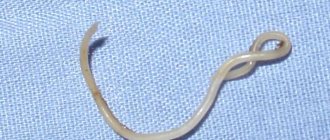What is cheyletiellosis
The disease affects various types of animals:
- cats;
- dogs;
- hamsters;
- guinea pigs.
Cheyletiellosis is characterized by rapid transmission from sick individuals to healthy ones. The disease is caused by the tick Cheyletiella blakei, which can be examined in detail under a microscope.
The dimensions of the parasite are from 0.25 to 5 mm. Its body is colored yellowish and has an oval shape. The pathogen has a powerful mouth, and successfully stays on the body of the “host”.
The main habitat of the tick is the keratin layer of the animal's skin. The parasite does not penetrate deep into the epidermis. Favorite areas of the body are the back, neck, groin, and the area behind the ears. Sometimes Cheyletiella blakei is found in the nostrils.
Parasites regularly lay eggs attached to the hairs. Hatched larvae go through a development cycle in 1-1.5 months, then become sexually mature individuals.
Pathogens and causes of the disease
The causative agent of the disease is mites of the genus Cheyletiella, which spend their entire life cycle on the host, or more precisely, on his skin.
It is here that cheyletiella undergoes six stages of development:
- The fertilized eggs laid by the female are secured by the female to the animal's hair using thin silky threads, forming a kind of cocoon.
- After an incubation period of 3-4 days, six-legged larvae are born.
- After 7.5 days they turn into protonymphs, but with 8 legs.
- After another 4-5 days, the protonymphs turn into 8-legged deutonymphs.
- After another 5 days, the deutonymphs enter the adult stage.
- They then develop into adult ticks, females and males that are whitish-yellowish in color and live for about 14 days.
How does the disease progress in cats?
In most pets, feline cheyletiellosis provokes moderately severe symptoms. Often the manifestations of the disease resemble allergies.
Adult animals have good tolerance to pathology. Often in these cats the disease goes away without obvious signs and does not cause a significant deterioration in health.
It is important to know! Kittens under 6 months of age and older pets react most severely to the disease.
The pathology is considered dangerous even if it is asymptomatic. The infection tends to instantly spread to others (both animals and people). The disease spreads especially quickly in the absence of high-quality conditions for keeping cats, or in the absence of several pets living in the house at once.
Veterinarians warn that it is better to refuse independent attempts to cure a cat. Such actions often end in failure and can cause further harm. If the first symptoms of feline cheyletiellosis appear, you should immediately visit a doctor.
Danger to humans
In some cases, the disease can affect owners of infected pets. Infection of owners occurs quite often - in 30% of cases.
The parasite settles on the human body temporarily, but manages to cause unpleasant symptoms:
- itchy rash;
- small erythematous papules on the trunk and arms.
It is possible to completely get rid of the disease and protect all inhabitants of the house from the risk of infection with the Cheyletiella blakei mite only after the pet has fully recovered.
It is possible to defeat parasites!
Tips from our readers
I got rid of parasites in just a week! I was helped by a remedy that I learned about from an interview with a parasitologist.
Toximin® - a remedy for parasites for children and adults!
- Dispensed without a doctor's prescription;
- Can be used at home;
- Clears parasites in 1 course;
- Thanks to tannins, it heals and protects the liver, heart, lungs, stomach, and skin from parasites;
- Eliminates rotting in the intestines, neutralizes parasite eggs thanks to the F molecule.
A certified remedy recommended by helminthologists for getting rid of parasites at home. It has a pleasant taste that children will like. Consists exclusively of medicinal plants collected in environmentally friendly places.
There is a discount now. The drug can be obtained free of charge.
Hello, readers of the site about parasites Noparasites.ru. My name is Alexander Lignum. I am the author of this site. I am 23 years old, I am a 5th year student at the Kemerovo State Medical Institute. Specialization "Parasitologist". Consultation by phone: +7. More about the author>>
How does infection occur?
The cause of infection with harmful mites is most often direct contact with a sick cat. Also, Cheyletiella blakei infection occurs as a result of touching the things of an infected animal.
In addition to contact, a cat can contract an infection after drinking contaminated water or poorly processed meat. Some pets become infected with ticks from flies, fleas, and lice that carry this parasite.
In more rare cases, infection results from living in apartments or houses where carriers of the disease were previously present. Sexually mature individuals of Cheyletiella blakei have the ability to exist for some time outside the body of the “host” (this period is measured in 2-10 days). If a suitable “candidate” appears within the tick’s reach, it cannot avoid an instant attack from the hungry parasite.
Causes
In cats, cheyletiellosis is caused by the microscopic mite Cheyletiella blakei. The parasite is invisible to the naked eye, its size is 0.25-5 mm. The tick has an oval shape and is colored light yellow. It has a powerful mouth consisting of large clawed parts.
The parasites attach the laid eggs to the fur of the “host”. The larvae that emerge from them successively turn into nymphs and adult ticks (within 35-40 days).
The habitat of Cheyletiella blakei is the keratin layer of the epidermis located in the back, neck, groin, and behind the ears. Parasites are also able to “settle” in the nasal passages. Mites do not penetrate the inner layers of the skin.
Toxoplasmosis
Where does a domestic cat get fleas?
Cheyletiellosis
Infection with cheyletiellosis occurs in several cases:
- during contact with a sick animal;
- when using things from an infected cat for a healthy cat (bedding, toys, combs);
- when your pet consumes unprocessed meat or dirty water.
Adult Cheyletiella blakei ticks are capable of existing outside the host's body (females - up to ten days, males - up to two). When a suitable “candidate” appears, they immediately settle on it. In such a situation, contact with the animal or its things is not necessary for infection.
Sometimes infection occurs when moving to a new apartment or house where sick individuals previously lived. Less commonly, small insects - flies, lice, fleas - take on the role of tick carriers.
Symptoms of the disease
Symptoms of cheyletiellosis can appear in cats within a short period of time after infection. The disease is accompanied by:
- peeling of the skin, the formation of ulcers, papules, and areas with erosions;
- hyperpigmentation of the epidermis;
- skin itching;
- hair loss, fraught with partial or complete baldness;
- loss of appetite;
- apathy;
- insomnia.
As the disease progresses, body temperature may rise. Sometimes disorders of the digestive system develop and allergic reactions occur.
This pathology is characterized by movement of areas of the epidermis susceptible to damage. Due to this feature, cheyletiellosis is also called “stray dandruff”.
To reduce the itching sensation, sick animals itch vigorously and scratch their skin until blood appears. Many pets acquire a sloppy appearance, become disheveled and restless.
Cheyletiellosis not only causes discomfort and deterioration in the appearance of the cat. Pathology can significantly weaken the animal’s immune system, making it defenseless against viral and bacterial infections.
Symptoms
Symptoms of cheyletiellosis appear soon after infection by a pathogenic mite.
The main manifestations of the disease in cats are:
- peeling of the skin;
- skin itching of varying degrees of intensity;
- hair loss leading to baldness;
- the appearance of papules, pustules, ulcers, erosions on the skin;
- skin hyperpigmentation;
- movement of areas of the affected epidermis (dandruff movement).
A sick pet has a disheveled, sloppy appearance, often licks itself and scratches itself. Trying to get rid of itching and discomfort, the animal is capable of scratching the skin vigorously, tearing it until blood appears. The presence of mites in the nose provokes frequent sneezing.
Cheyletiellosis in cats can occur with an increase in body temperature, disorders of the gastrointestinal tract (diarrhea, constipation, flatulence), and allergic reactions. Often, sick pets become lethargic, apathetic, lose interest in food, experience increased anxiety, and insomnia.
Infection with a parasite can lead to weakened immunity, deprive the body of natural defenses against viral and bacterial infections, and make the cat excessively sick. In large cats, the disease occurs with mild symptoms. Hair loss occurs in small amounts, most often on the sides.
Diagnosis of cheyletiellosis in cats
The first stage of examining your pet is a general clinical examination, which allows you to immediately identify the largest parasites. To obtain complete information about the course of the disease, laboratory procedures are necessary.
Diagnostics continues using the following methods:
- examination of combed wool, which makes it possible to detect adult individuals and the eggs they have laid;
- scraping or tape test, which helps identify dead scales of the epidermis;
- trichogram, which specifies the degree of hair loss.
Cats often swallow ticks by licking their lips. For this reason, many veterinarians additionally order a stool test.
Differential diagnosis makes it possible to distinguish cheyletiellosis from diseases with similar manifestations. Special procedures help to detect the difference between this pathology and demodicosis, sarcoptic mange, seborrhea, and dermatophytosis.
Treatment of feline cheyletiellosis
Treatment measures must be carried out without delay, immediately after confirmation of the diagnosis. The basis of therapy is the use of antiparasitic agents applied to the skin of the cat. In order to ensure complete treatment of problem areas, long hair is trimmed.
Owners of sick cats need to remember the following:
- if there are several pets in the house, they all must undergo treatment (otherwise the disease will quickly spread to healthy individuals);
- while carrying out therapy, you need to simultaneously monitor the cleanliness of the house, sanitize cat bedding, accessories, dishes, and treat upholstered furniture (using chlorine-containing products);
- it is important to regularly bathe a sick pet, thus speeding up the cleansing of the skin from parasites;
- Medications should be applied only after water procedures.
The causative agent of the disease is characterized by high vitality. To clean the animal’s skin and the entire room from ticks, you must strictly follow all the instructions of your doctor.
Essential Medicines
Treatment for cheyletiellosis in cats takes 6 to 8 weeks. Special veterinary preparations are used to treat the pet’s skin.
The following topical medications help defeat the parasite:
- Butox;
- Demos;
- Acaromectin;
- Ivermec spray;
- Leopard.
Such medications are used 2-3 times in a row. Next, a break of up to 2 weeks is required. For faster restoration of damaged skin and coat, cats are additionally recommended vitamin and mineral complexes with biotin.
The main course is often supplemented by the administration of Ivermectin tablets taken orally. In difficult cases, injections with Ivermek are necessary.
It is prohibited to give injections yourself for cheyletiellosis in cats. Such procedures can only be performed as prescribed by a veterinarian. .
How is cheyletiellosis transmitted?
What doctors say about treating parasites
Doctor of Medical Sciences, Professor German Shaevich Gandelman
Work experience: more than 30 years.
I have been detecting and treating parasites for many years. I can say with confidence that almost everyone is infected with parasites. It's just that most of them are extremely difficult to detect. They can be anywhere - in the blood, intestines, lungs, heart, brain.
Parasites literally devour you from the inside, at the same time poisoning your body. As a result, numerous health problems appear, shortening life by 15-25 years.
Prevention of feline cheyletiellosis
Primary prevention of cheyletiellosis in cats is ensured by regular washing of the pet, keeping the animal, its accessories, dishes, toys, etc. completely clean. An important role in the prevention of parasitic infection is played by a balanced diet, fortification, carried out several times throughout the year, and the exclusion of contacts with unclean stray animals.
After an illness, it is important to take all measures to prevent its recurrence. It is necessary to carry out frequent cleaning of the premises, using insecticides and preparations containing chlorine. To exclude recurrent cheyletiellosis in cats, it is necessary to treat the animal’s bedding with acaricidal agents (3-4 procedures are sufficient, with 5-day intervals between them).
Our materials will be useful for you and other users. Share the article on social networks! Click!











